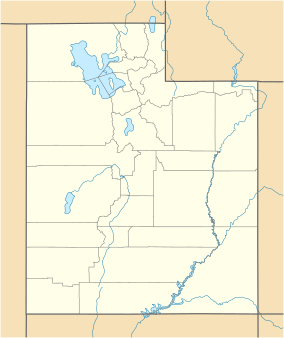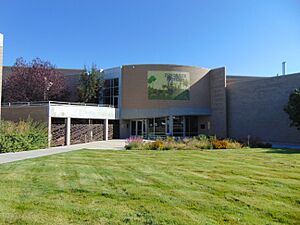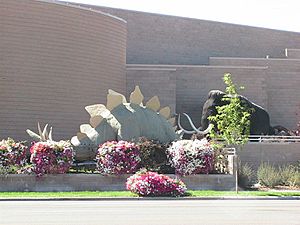Utah Field House of Natural History State Park Museum facts for kids
Quick facts for kids Utah Field House of Natural History State Park Museum |
|
|---|---|

Allosaurus skeletal reconstruction
|
|
| Location | Uintah, Utah, United States |
| Area | 2 acres (0.81 ha) |
| Elevation | 5,300 ft (1,600 m) |
| Established | 1948 (as a museum) 1959 (as a state park) |
| Visitors | 61,657 (in 2022) |
| Operator | Utah State Parks |
| Website | Official website: https://stateparks.utah.gov/parks/utah-field-house/ |
The Utah Field House of Natural History State Park Museum is a super cool place in Vernal, Utah, USA. It's both a museum and a state park! Here, you can explore amazing things from Earth's past. You'll see ancient fossils and learn about the people who lived here long ago. It's a perfect spot for anyone curious about nature and history.
Contents
Discover the Utah Field House Museum!
The Utah Field House of Natural History State Park is a special place. It has a large building that is about 22,000 square feet. This building sits on a property that is 2 acres big. The museum shows off many items from ancient times. These include rock formations, human history, and natural history items. All these treasures were found near the Uinta Mountains and in the Uinta Basin.
You can also enjoy a picnic here. If you want to camp, there are great spots nearby. Check out Red Fleet State Park, Steinaker State Park, or Dinosaur National Monument.
Exploring the Museum's Cool Exhibits
The Utah Field House of Natural History has lots to see! Inside, you'll find a round main area called a rotunda. There are three big exhibit halls, a classroom, and a theater. Outside, there's even a fun garden.
Journey Through Time: Geology Hall
The Geology Hall takes you on a journey through time. You'll see algae, dinosaur, and mammal fossils. These fossils cover more than 600 million years of Earth's history! There are also cool artworks showing these ancient creatures. You can also see paintings of the local rock formations.
Human Stories: Anthropology Hall
In the Anthropology Hall, you'll learn about the people who lived in this area. It features items from the Fremont Indians. You can also see copies of local petroglyphs, which are ancient rock carvings. Plus, there are beautiful Ute handicrafts and other cultural items.
Wild Utah: Natural History Hall
The Natural History Hall shows you the animals that live in Utah today. You'll see examples of local wildlife. They are arranged along a big painting of the local environment. This painting shows everything from the high Uinta Mountains to the lower Uinta Basin.
Meet the Dinosaurs: Outdoor Garden
Outside the museum is the exciting Dinosaur Garden! It has 17 life-sized replicas of prehistoric animals. These models show creatures from different ancient times. You can see a huge 20-foot Tyrannosaurus and a Stegosaurus. There are also two Moschops. Most of these amazing models were made by sculptor Elbert Porter. The museum bought them in 1977. The newest addition is a Coelophysis model. Artist David Thomas created it, and it joined the garden in 1993.
How the Museum Started
Back in 1945, the Utah State Legislature decided to build a natural history museum. This museum would be in Vernal. Local groups, like the Lions Club, worked hard to make this happen. They wanted a place to keep and show ancient fossils and other natural history items. Money was set aside in 1946. The museum officially opened its doors in 1948. Since then, millions of people have visited this wonderful place!
More Places to Explore





